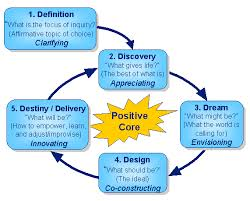As a CRM Leader or Salesforce admin, deploying new products, features in Salesforce at the end of the day boils down to effective change management processes put in place in the organization. Organizations spend thousands of dollars in implementation but still suffer from low adoption and change not effectively communicated to Users. So As a Salesforce CRM Leader or admin, what is the best way to put a change management policy in the organization and ensure adoption is increased? Here is my post on Appreciate inquiry process which is presented to you in a question and answer format to better understand the principles of this process.
What is it? And why do we need to learn about it?
Appreciative Inquiry is both a change management methodology and a set of foundational principles. I have found it a very effective and efficient approach particularly valuable in our current pandemic environment. First developed by David Cooperrider in his 1986 dissertation studying the Cleveland Clinic, Appreciative Inquiry is an approach based on optimizing organizational strengths rather than overcoming organizational weaknesses. Instead of starting with a gap analysis, it starts with a strengths analysis and builds on assets to ideate and achieve organizational goals. Here’s the 5-D process as described on the AI Commons website, a resource for learning about Appreciative Inquiry:

While the process is how Appreciative Inquiry is conducted as a change management methodology, its foundational principles are what make it powerfully unique:
| Principle | Summary | Details |
| Constructionist Principle | Words create worlds | The reality, as we know it, is a subjective vs. objective state and is socially created through language and conversations. |
| Simultaneity Principle | Inquiry creates change | The moment we ask a question, we begin to create a change. “The questions we ask are fateful.” |
| Poetic Principle | We can choose what we study | Teams and organizations, like open books, are endless sources of study and learning. What we choose to study makes a difference. It describes – even creates – the world as we know it. |
| Anticipatory Principle | Images inspire action | Human systems move in the direction of their images of the future. The more positive and hopeful the image of the future, the more positive the present-day action. |
| Positive Principle | Positive questions lead to positive change | Momentum for [small or] large-scale change requires large amounts of positive affect and social bonding. This momentum is best generated through positive questions that amplify the positive core. |
– From Cooperrider, D.L., & Whitney, D. A Positive Revolution in Change: Appreciative Inquiry. Taos, NM: Corporation for Positive Change, 1999.
Why do you need to follow the Appreciative Inquiry process and how is it better than other methods?
Of all the change management and consulting approaches I’ve tried, this one is simply the most productive and fastest. The key is that the underlying principles define a very different starting point than most methodologies. Most processes have you talk about gaps, problems, and pain points. While cathartic, this process often leads to a significant amount of time spent venting, complaining, and then actively defining what we don’t want or like about how things are. It drags energy downward and backward as people focus on bad things about the past. Appreciative Inquiry doesn’t entirely skip those, rather it reframes and refocuses. Past gaps and problems are useful as examples of what we really want to create. Instead of spending valuable time on the past, Appreciative Inquiry moves people to talk about what they want and what assets they can use to get there. It’s a much more constructive, future-focused approach.
What are the use cases which are suited for this? What are the use cases for which this methodology does not apply?
The foundational principles of Appreciative Inquiry are useful anywhere, particularly as a leadership approach. As a methodology, Appreciative Inquiry is very flexible and applicable for most use cases. I find it particularly useful for technology projects. It keeps peoples’ energy on higher-level goals rather than becoming mired in detail, as is common in these projects.
It might be less applicable in two specific situations. First is a situation where there’s a clear need for a well-defined expert solution. If it’s just a matter of consultative expertise, that’s a simpler change management need. The second is where there is deep-seated mistrust, malfeasance, or some other severe negative. The approach itself could be very valuable, but it would need to be conducted by an extremely skilled facilitator and team. It all starts with the right question.
4. What are the myths and misconceptions about it?
A major misconception is that Appreciative Inquiry glosses over and tamps down the negatives. Less skilled practitioners sometimes perpetuate this when they say in response to a negative comment, “We’re not focusing on that…” It takes someone who really understands not just the process, but the foundational principles, to do the energy Aikido required in those moments. Most of the time, the negativity can be expressed as, “What do you wish could happen?” or “How would you like it to be instead?” The past is a jumping-off point for the future. Framed that way, all past experience, good and bad, is simply constructive. The key reason for staying future-focused and constructive lies in some of the foundational Appreciative Inquiry principles. The simultaneity principle suggests that the instant you ask a question, you’ve already created change. How you frame a conversation sets the tone and can help determine the outcomes. So taking great care in the questions and framing of your topic, question, or issue is critical to its success. The anticipatory principle suggests that what we focus on grows. Ever notice how you never see a certain car on the road until you purchase one, and then you see it everywhere? You find what you look for. If you look for the bad and what can’t be done, you’ll find it. If you look for the good and what’s possible, you’ll find it. The positive principle suggests when you focus on the positive, constructive, beneficial, you’re more likely to put your energy there and achieve it. Combined, the process suggests that if you focus attention from the outset on constructive positive outcomes, you’ll pull energy in that direction and be more likely to achieve it. It’s faster and more productive than a deficit-based approach. Finally, we identified specific project opportunities that would most help us meet those aspirations and the metrics that we’d use to measure them. The process was positive, collaborative, and fast.
Are there any gotchas which we need to consider when we implement an appreciative inquiry process during a project implementation?
New practitioners can get in over their heads if they haven’t really worked with Appreciative Inquiry before and don’t fully understand the principles. If someone brings up a negative point, less-practiced facilitators might try to chastise the speaker, blame the process, scrap the process, or generally overreact. It takes skill to use everything in the room and to facilitate it constructively. The main focus of Appreciative Inquiry is generativity – taking what’s there and using it constructively.
Another gotcha is similar to any other change management process: losing steam and not finishing. It’s important to communicate the whole way through the closure of any change management process. Without closing the loop, it may leave participants feeling at best incomplete and at worst, that it failed. Appreciative Inquiry offers the potential to keep building upon itself – discovering new assets and strengths and developing new aspirations. Remember to keep the momentum going.
Let me add one final word about the Appreciative Inquiry principles. There’s a lot to unpack individually, and they’re quite a powerhouse of perspective together. Here’s a simple example of the positive and anticipatory principles: Why do we always say “don’t forget” to do something? Is the assumption that we all have terrible memories? Doesn’t it seem odd to say not to do something? At work and home, I’ve changed to saying “remember” instead. It’s a tiny change towards positivity, and it matters. Another example is the growing research on the benefit of gratitude practices. Gratitude reflections exemplify the poetic, positive, and constructionist principles – we look for things to be thankful for and spend time thinking about them. This practice helps us find more ways to be grateful and adds much-needed perspective. The Appreciative Inquiry process is extremely effective, and I also suggest spending some time with the principles for a strong foundation and overall benefit.
To learn more about Appreciative Inquiry, check out the AI Commons, and if you’d like to dig into the principles in a unique way, here’s a series of six 5-minute guided Appreciative Inquiry Meditations.
Appreciate Inquiry Process for Higher Ed CRM Implementations
Send download link to:
Please subscribe
Subscribe to our mailing list and get tips to maximize salesforce to your email inbox.
I am honored to have your subscription. Stay tuned for tips to maximize your salesforce investment
Something went wrong.





